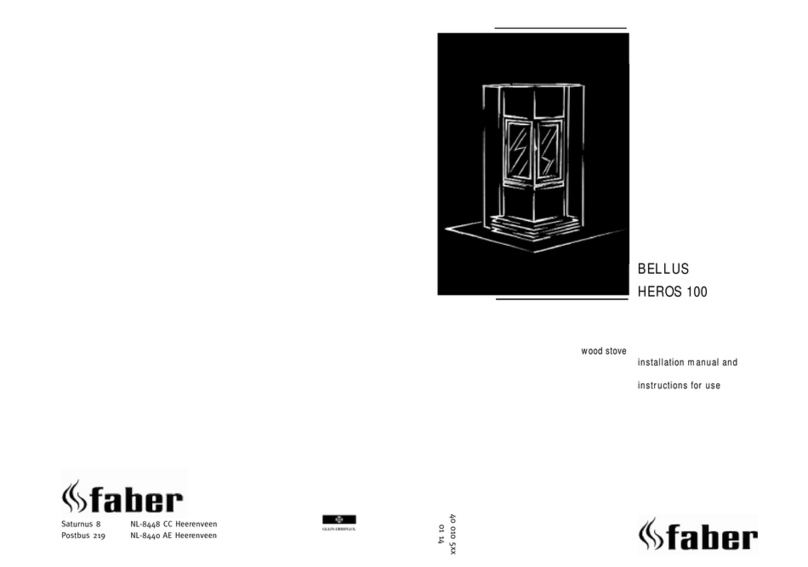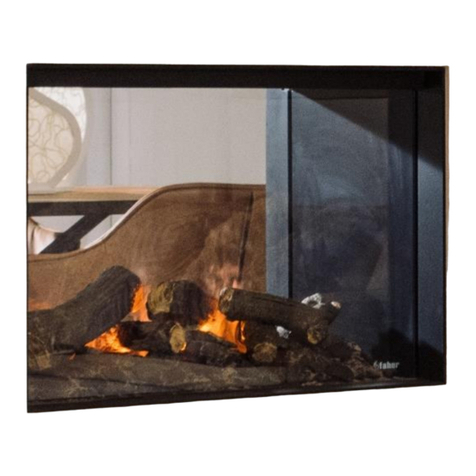Faber HAAKON User manual

Assembly and operating instructions
for freestanding wood stove models:
HAAKON BRANDE 82
April. 2007

2
OPERATING INSTRUCTIONS
Dear Faber Customer,
We are pleased that you have decided to purchase a Faber-free standing
stove.
The elegant design and state-of-the-art combustion technique of the
Haakon and Brande models will certainly offer you many unforgettable cozy
evenings in front of the wood stove.
As a user of a wood stove, you should carefully study the attached
assembly and operating instructions for the correct way to operate the
stove.
Please read this manual carefully before installation and commissioning.
These instructions give you important information and useful tips for romantic
moments in front of your wood stove. Keep this guide close by to allow you to
carry out the correct operations at the beginning of the heating period.
A guarantee from your dealer ( or your contractor) can only be honoured if the
attached operating instructions have been respected and you have the original
bill.
In the case of misuse, failure to comply with the operating manual or use of
force, the guarantee is no longer valid.
Paint damage is only covered by the guarantee if this is immediately notified in
writing to the dealer on delivery of the wood stove.
Any transport damage is not covered by the guarantee (this must be claimed
against the carrier in accordance with the terms of the carrier).
We wish you much pleasure with your new wood burning stove.
Faber International BV
Customer Service
Saturnus 8
PO BOX 219
NL-8440 AE Heereveen
The Netherlands

3
1. ASSEMBLY
1.1 Building regulations
Your stove is designed for heating of living rooms as supplementary heating or
for heating during the transitional heating up period. The device is not suitable
as the unique form of heating for apartments or entire floors. We recommend
that before installation of your wood stove you talk with your district chimney
sweep. He can advise you on the relevant building regulations, examine the
chimney, grant the authorisation and arrange for the approval. Check whether
the room in which the wood stove is to be installed is adequately supplied with
fresh air. To ensure trouble-free operation of your stove, an adequate supply of
combustion air is required from the living room. The stove may not be modified.
1.2 Combustion air supply:
The arrangements for a combustion air supply may not be modified. In
particular, it must be ensured that the required combustion air pipes are open
during operation of the wood stove.
For this reason, if you have the intention to seal windows and doors with
special sealing you should obtain professional advice. Your contact in this case
is the chimney sweep, plumber, heating engineer or your energy supplier.
These professionals can tell you what must be done.
1.3 Chimney
The performance of your wood stove also depends on your chimney. It can be
affected by the cross-section of the chimney or by an effective chimney height
of less than 4.50 m. The effective chimney height is the distance between the
flue gas entry and the upper edge of the chimney.
Cooker hoods, which are installed in the same room or contiguous air
area as the wood stove may adversely affect the functioning of the
wood stove (up to the smoke outlet in the living room despite a closed
fire box door) and must, therefore, in no case be operated simultane-
ously with the stove.
In the case of sealed windows and doors (e.g. as part of energy-saving
measures), it may be that the fresh air supply can no longer be guaran-
teed thus affecting the functioning of your stove. This can negatively
affect
y
our wellbein
g
and
y
our safet
y
under certain circumstances.

4
1.4 Chimney and flue pipe connection
To connect the stove to the chimney, you should ask a specialist or the
chimney sweep. They are familiar with local regulations, so that the correct
connection of the stove chimney is guaranteed.
When the wood stove is installed with an upper outlet, the flue pipe (2 mm thick
steel plate) must have an inner diameter of 150/120 mm and a minimum
vertical distance of 50 cm. The horizontal length to the chimney connection
should not exceed 100 cm. The flue pipe must be installed with a minimum
inclination of 5 cm. It is not allowed to install a 90 degree bend from the stove
into the chimney. To ensure a good draught through an existing chimney
linning of the chimney with solid fuel liner is usually requiered.
Failure to comply with these connection requirements means that the
correct operation of the wood stove is no longer possible and the
guarantee is void.
Make sure that the connection to the chimney and all the connecting pieces to
the stove and chimney fit well with one another and are sealed and tightly
connected. The pipe has to be well sealed at the chimney entry and may not be
installed in the chimney cavity itself, otherwise the smoke draught would be
affected. We recommend the use of a double wall lining here. The chimney
should have an easily accessible soot door.
We recommend that the chimney or the pipe is equipped with a damper so that
the chimney draught can be regulated on days with strong winds. It is not
allowed that the damper close the pipe totally. There must always be a free
area of min. 20% of the total opening of the chimney or the pipe.
All combustible or temperature-sensitive materials on and in the wall must be
removed and replaced with non-combustible materials within a radius of 20 cm
of the connection opening,.
1.5 Note with respect to a chimney fire:
If incorrect or damp wood is used, this may lead to a chimney fire due to
deposits in the chimney. If this occurs, close all air vents connected to the wood
stove and check that all the cleaning access traps to the chimney are closed.
After the fire goes out in the chimney, get a specialist to check for cracks or
leaks.
1.6 The design
The Haakon/Brande 82 wood stoves are designed and tested in accordance
with DIN 18891-1/ EN 13240. It must only be operated when the fire box is
closed and it is already connected to a suitably-installed chimney.
1.7 Temperature-sensitive materials
For combustible flooring such as wood, carpet, etc. a base plate must be used.
(please read also Chapter 2: SAFETY).

5
IMPORTANT:
The company is not liable for any damage or defects in the stove or its
components which are caused by disregard of building regulations, incorrect
choice of the stove size, non-professional pipe and equipment installation,
faulty chimney connection and using unauthorised fuels, due to faulty, improper
operation or inadequate or overly-strong chimney draught, as well as through
external chemical or physical effects during transport, storage, installation and
use of the device (for example quenching with water, over-cooking food and
beverages, condensation, overheating through too much of the wrong fuel). In
addition the company is not liable for damage occurring as a result of building
up of soot due, for example, to poor chimney draught, wet wood or incorrect
operation and leading to losses such as additional heating costs in the event of
repair, as well as transportation costs and costs for the installation and removal
of the stove.
2. SAFETY
2.1 General safety precautions
-The existing safety measures cannot exclude all risks of accidents in
dealing with the stove.
-Remember that most components in the stove (flue pipe, safety window,
cladding and controls, etc.) become hot during heating and therefore
represent a combustion hazard. So please use gloves.
-Children should never be left unattended with a burning wood stove.
Ensure that they never play with the stove controls.
-never use spirits, alcohol, petrol or other flammable liquids.
-Only use the fuel specified in the owner's manual for heating.
-If work is being carried out on flammable or explosive materials in the
vicinity of the stove, the stove must be put out of operation.
-The fire box door must always be kept closed during operation.
-The shaker grate lever must only be handled when wearing a glove!
-The stove should only be operated with the ash tray inserted. Empty the
ash pan regularly. The ash should be disposed of when cold.
2.2 Installation instructions and safety clearances
The wood stove must be installed in a floor space with adequate load carrying
capacity. In the event of inadequate load carrying capacity, appropriate
measures must be taken in order to achieve this (for example a plate to
distribute the load).
The building regulations and fire brigade provisions, national and
European standards, and local regulations for the installation and
operation of the wood stove need to be respected.
This manual suits for next models
1
Table of contents
Other Faber Wood Stove manuals
Popular Wood Stove manuals by other brands

RAIS
RAIS attika NEXO 100 GAS installation guide

WoodPro
WoodPro WS-TS-1500 owner's manual

Contura
Contura C 586W installation instructions

Palazzetti
Palazzetti EVA GENERAL INFORMATION - WARNINGS - INSTALLATION - MAINTENANCE

Lopi
Lopi 1250 Republic owner's manual

Panadero
Panadero CAPRI 3V Usage and maintenance instructions













